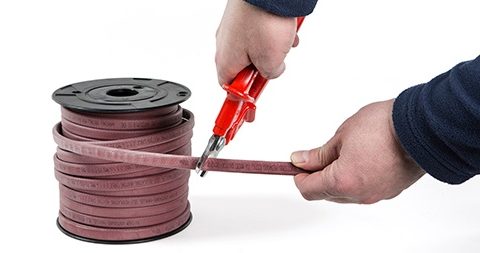When it comes to ensuring your building is protected against winter weather, there are lots of options. Many will turn to heat tape or heat cables. But which is better for protecting your building?
What is Heat Tape?
Despite its name, heat tape isn’t something that can be stuck onto pipes or roofing for freeze protection. In fact, it’s a type of cable. Unlike self-regulating heating cables, however, heat tape comes in fixed, flexible lengths that cannot be adjusted on the fly. Heat tape can often be referred to as constant wattage cable.
What are the Limitations of Heat Tape?
While heat tape can work for many projects, there are some limitations that make it less than ideal for some systems.
- Cables that touch or overlap can overheat which leads to cable burnout and may be a safety risk.
- If the cable is damaged anywhere along the length, the entire circuit is lost. This means maintenance needs for damaged cables should be careful considered.
- In the event of cable damage, it generally cannot be repaired. This means you need to remove the old cable, re-trace the application and re-insulate.
- Constant wattage cable cannot be cut-to-length (must be ordered in exactly the correct length required).
Advantages of Self-Regulating Cable
If you are looking for more flexibility during project installation, self-regulating cable may be the right alternative to heat tape.
Some long-term benefits of self-regulating technology over constant wattage include:
- Durability
- Self-regulating technology allows cable to overlap without risk of burning out or fire
- Greater impact resistance
- Ease of design and installation
- Can be cut-to-length
- Easy to tee, splice and repair
- Ability to overlap cables simplifies design
- Lower cost of ownership
- Heater output is inversely related to the surrounding temperature, reducing output when less heat is required and maximizing energy savings
- Easier installation reduces time required, which reduces total installation cost.
- Easily repairable cable ensures damage can be repaired without replacing the entire circuit
- More durable cable makes repairs less likely and service life longer
If you are looking to install a self-regulating system, there are specific advantages to choosing the nVent RAYCHEM brand.
Self-regulating cable was invented by nVent RAYCHEM and we have refined the production of self-regulating cable to ensure even dispersion of conductive particles in the cable’s core and excellent contact between bus wires and the core. This ensures uniform heat distribution and prevents localized overheating.
Furthermore, our tightly fitted insulating jacket ensures efficient heat transfer while preventing premature aging of the cable.
Interested in learning more about our technology? Connect with an nVent RAYCHEM Winter Expert for more information on the benefits of heating cables.


